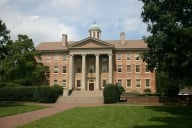You have /5 articles left.
Sign up for a free account or log in.
In the 90s, a typical night for Craig Seymour included G-strings, elbow grease, and dollar bills in his socks.
Between sets at Washington, D.C.’s gay strip clubs – unique institutions while they lasted, where hands-on experiences were encouraged -- he graded papers, “red pen in hand.”
“The truth was that stripping had long called out to me. It offered something different from my grad school grind of dealing with students, grading papers, and sitting through seemingly endless seminars.”
So Seymour writes in his new memoir, All I Could Bare: My Life in the Strip Clubs of Gay Washington, D.C. (Atria, 2008), his tell-all tale of getting eyed and groped while an American studies Ph.D. student (and teaching assistant) at the University of Maryland at College Park. The racy book doesn’t seem to have hobbled him on the academic hiring circuit: After three years at the University of Massachusetts at Dartmouth's English department, he heads to Northern Illinois University as an associate professor of journalism this fall, with credit toward tenure status. “It’s clear that he is working in defined academic traditions of ethnography and journalism, so I didn’t hear any hue and cry about it," Jeffrey Chown, incoming journalism chair at Northern Illinois, says of faculty reaction to Seymour's publication history.
“I actually read an excerpt,” Seymour, now 39 and with significantly more time logged as a journalist than as a stripper, says of his NIU campus visit. “I’m at the point in my career that I don’t want to be anywhere if people don’t want me exactly as I am.”
“In the same way you know how I say I don’t want my gravestone to read, ‘He never embarrassed his parents?’ I also don’t want my gravestone to read, ‘At least he got tenure.’”
Seymour’s stripping had its origins, appropriately, in academic enterprise. His master’s thesis, based on participant observation and interviews but not (at that point) practice, was entitled “Desire and Dollar Bills: An Ethnography of a Gay Male Striptease Club in Washington, D.C.” (He writes: “[B]y far the most controversial thing I did in the thesis – though it seemed like a good idea at the time – was to include an appendix with photocopies of pictures from gay porn magazines featuring models doing a full bent-over ass-cheek spread.” The appendix complemented his argument, in which he outlined “how the anus operates as a site of desire within the context of clubs.”)
Soon after turning in the thesis, a dancer named Nico challenged Seymour. Why, given his great interest, didn’t he give stripping a go?
So, Seymour did.
Seymour writes that, "far from being an anomaly -- the grad student stripper -- I was practically a cliché. I'd since met so many other guys, and women, who put themselves through school by taking off their clothes." Questioned on that statement in an interview -- Really? It's that common? -- Seymour laughs like someone in-the-know. "If anything, if I was writing that now, I would take out the 'practically,'" he says. "If you think about it in terms of the schedule too, it works perfectly for a grad student."
But for him, Seymour explains, his reasons why weren’t really about making money, other than that “as a poor grad student it was nice having that money.”
“The overall context was all about me....It was about feeling insecure about myself."
In his memoir, Seymour chronicles the roller-coaster ride of choices that shape his life as a stripper, ending with his emergence as an entertainment journalist able to ask Janet Jackson anything and everything (including about “big dicks and masturbation”) for a VIBE cover story. After a long leave of absence, he wrote his dissertation on the construction of a pop culture icon (a topic more relevant to his first book, on Luther Vandross) and earned his doctorate in 2005. One year later, already settled in Massachusetts as a professor, he returned one final time to Washington's clubs -- before they were razed to make way for a new baseball stadium.
“The reason I did this book was because I thought it was an interesting story about a time I really did think was culturally significant,” Seymour says. Reduce the strip club scene to a bunch of old guys lusting over young ones if you will, Seymour says, but the clubs were “founded by a generation of gay men that really had no place else to go." In his book, Seymour also describes a sense of relief that he, as a young gay man, felt upon first finding the clubs: At last able to look, really look, at other men without fear of getting beat up.
And while he didn't want to write on stripping in dissertation or monograph form, his book is informed by academic theory, he says. Seymour hopes that people can take the book to the beach and view it as a historical document -- even with its generous spattering of four-letter words and graphic slang.
So would he ever pull the old professor trick and assign this book to his students?
“Never, ever, in any circumstance in life, would I ever, ever, ever assign the book.”








